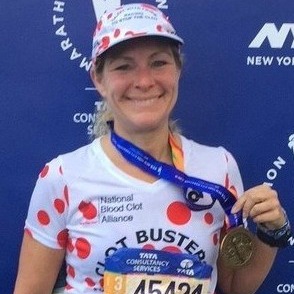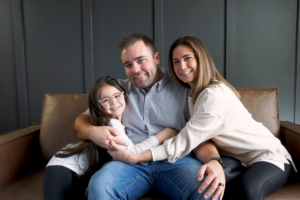I still have the notes I wrote before visiting a doctor in April 2012: I am not feeling well. Did triathlon, and couldn’t catch my breath during swim or run. I am winded going up a flight of stairs.
Little did I know I was experiencing the signs of a blood clot. Six months later, I survived bilateral pulmonary emboli (PE), blood clots in both lungs. I was lucky that my mother, a PE survivor, was traveling with me. She called a doctor to our hotel, when I was completely out of breath and my heart was pounding — me, the triathlete. Without my mom, I would have laid down on the hotel bed and never woken up.
I was lucky to survive, but so many more who suffer from blood clots aren’t nearly as lucky. That’s why I’m asking you, on behalf of the National Blood Clot Alliance (NBCA), to join me in saving lives by making a gift today. Critical research efforts are crucial to saving lives, as is educating the public about the dangers of blood clots.
As a member of the NBCA community, I’m sure you are aware that blood clots do not discriminate by age, gender, ethnicity or race, and are often misdiagnosed. And yes, even athletes are affected by blood clots.
After a doctor mistook my shortness of breath for anxiety, I ignored further signs of a blood clot, thinking the pain in my calf was due to intense triathlon training. Today, I know that hormonal birth control, long-distance travel, and other factors put people at increased risk for developing blood clots, but I didn’t know that then.
I wasn’t alone. Studies show that fewer than 1 in 4 people have any recognition of blood clots or their signs and symptoms. Because of this, too many lives are lost…
- 274 people in the U.S. will die every day due to a blood clot
- 900,000 new blood clots are diagnosed in the U.S. every year
- 100,000 deaths occur due to blood clots in the U.S. every year
Like anything else in my life, I couldn’t take what I’d learned about blood clots lying down. With a desire to bring awareness of the dangers of blood clots to more people, I took action, and you can too.
As a blood clot survivor, it was so important for me to run the 2016 New York Marathon on behalf of NBCA with Team Stop the Clot®, a dedicated team of new runners each year, made up of both survivors and loved ones running in memory of those who lost their lives to blood clots. It was a challenging course and an amazing experience, with cheering crowds throughout. I was pleased with my time of 4:25 and glad to finish feeling strong—for myself and for NBCA. I’m so fortunate that it was me running my own race, and not a loved one running in my memory. Furthermore, I’m proud to have had the support of family and friends, who helped me raise nearly $5,000. Now, I’m reaching out to you, so NBCA can keep running toward blood clot awareness and education.
These days, my mom and I are both healthy and follow doctors’ orders around blood clot precautions, including me taking a blood thinner when I travel more than 3 hours by plane. I keep training and will run my ninth marathon in October. I am not running from PEs — I don’t let the past negatively impact my future — but am honored to be able to run toward a healthier future for us all.
Because blood clots do not discriminate, I’m reaching out to you today, wherever you are in life, for help for those who need it now. More people die each year due to blood clots than due to AIDS, breast cancer, and automobile accidents, combined. Yet, blood clots are preventable and treatable if you know the signs. Let’s learn the signs and keep NBCA running toward greater public awareness, better research, and saved lives.
Thank you in advance for joining me in stopping the clot.
Sandy Nelson





